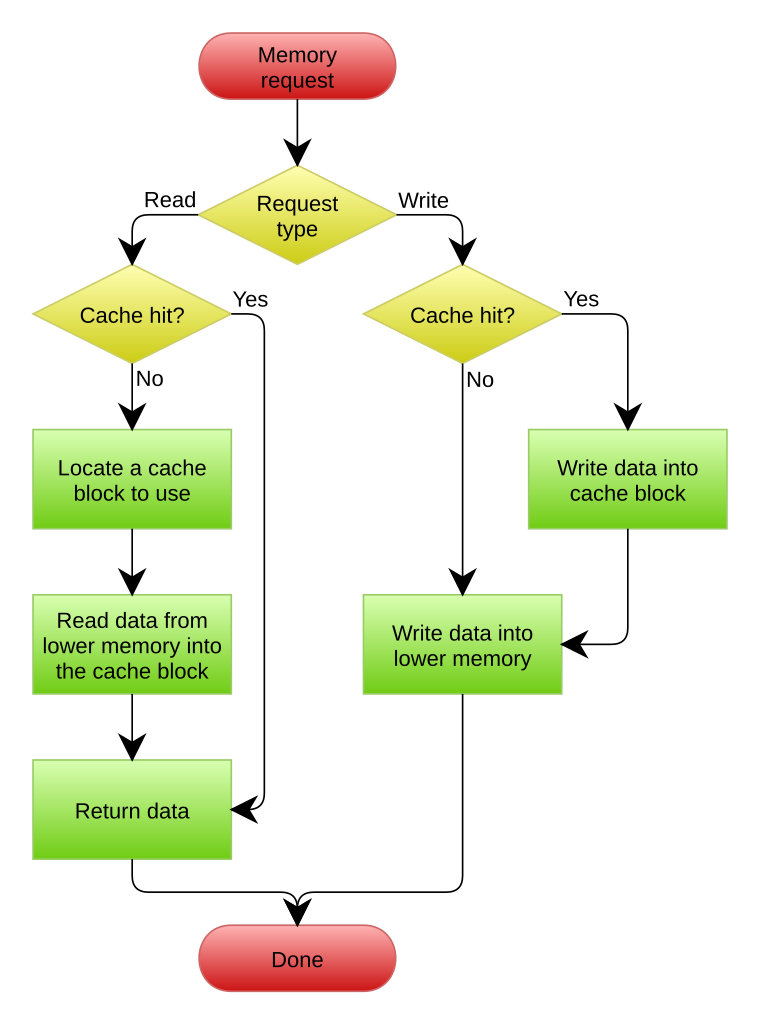MIME
Multipurpose Internet Mail Extensions (MIME) is a standard that extends the format of email messages to support text in character sets other than ASCII, as well as attachments of audio, video, images, and application programs. Message bodies may consist of multiple parts, and header information may be specified in non-ASCII character sets. Email messages with MIME formatting are typically transmitted with standard protocols, such as the Simple Mail Transfer Protocol (SMTP), the Post Office Protocol (POP), and the Internet Message Access Protocol (IMAP).
cache
In computing, a cache (/kæʃ/ ⓘ KASH)[1] is a hardware or software component that stores data so that future requests for that data can be served faster; the data stored in a cache might be the result of an earlier computation or a copy of data stored elsewhere. A cache hit occurs when the requested data can be found in a cache, while a cache miss occurs when it cannot. Cache hits are served by reading data from the cache, which is faster than recomputing a result or reading from a slower data store; thus, the more requests that can be served from the cache, the faster the system performs.
To be cost-effective, caches must be relatively small. Nevertheless, caches are effective in many areas of computing because typical computer applications access data with a high degree of locality of reference. Such access patterns exhibit temporal locality, where data is requested that has been recently requested, and spatial locality, where data is requested that is stored near data that has already been requested.
DDoS
Denial-of-service attack
In computing, a denial-of-service attack (DoS attack) is a cyber-attack in which the perpetrator seeks to make a machine or network resource unavailable to its intended usersby temporarily or indefinitely disrupting services of a hostconnected to a network. Denial of service is typically accomplished by flooding the targeted machine or resource with superfluous requests in an attempt to overload systems and prevent some or all legitimate requests from being fulfilled.[1] The range of attacks varies widely, spanning from inundating a server with millions of requests to slow its performance, overwhelming a server with a substantial amount of invalid data, to submitting requests with an illegitimate IP address.
In a distributed denial-of-service (DDoS) attack, hackers flood a target website with so much traffic from multiple systems that it is rendered inaccessible to legitimate users. A DDoS attack is different than a denial-of-service (Dos) attack, which usually attacks from a single system.
Because DDoS attacks originate from multiple sources and send a larger volume of traffic into the system at once, it is difficult for network administrators to quickly detect and eliminate the threat. As such, DDoS attacks are more damaging than standard DoS attacks as they put an excessive drain on resources and sometimes completely take down an entire network or website.
cloud storage
Cloud storage is a model of computer data storage in which data, said to be on "the cloud", is stored remotely in logical pools and is accessible to users over a network, typically the Internet. The physical storage spans multiple servers (sometimes in multiple locations), and the physical environment is typically owned and managed by a cloud computing provider. These cloud storage providers are responsible for keeping the data available and accessible, and the physical environment secured, protected, and running. People and organizations buy or lease storage capacity from the providers to store user, organization, or application data.
Cloud storage services may be accessed through a colocated cloud computing service, a web service application programming interface( API) or by applications that use the API, such as cloud desktop storage, a cloud storage gateway or Web-based content management systems.









